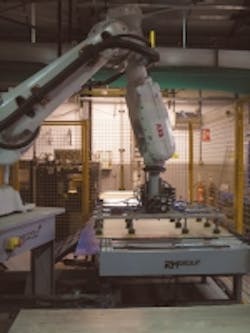Factory automation industry continues growth as record number of robots ordered in first half of 2016
During the first half of 2016, a total of 14,583 robots valued at approximately $817 million were ordered form North American companies, which represents a new record to begin the year, according to the Association for Advancing Automation (A3).
A3, which is also setting new records with its highest membership level ever with 965 member companies, notes that the number of units ordered in the first half of the year is 2% more than the same period in the first half of 2015, which held the previous record. Order revenue did decrease slightly, however, dipping 3% in the first half of the year. During the same timeframe, 13,620 robots valued at $838 million were shipped to North American customers. These figures represent the second highest totals for units shipped and a new record for shipment revenue in the first half of a year.
In terms of the markets that saw the most action, automotive OEMs and component suppliers ordered 16% more and 4% more, respectively, to begin the year, and was the largest driver of the market’s record performance. Orders for the food and consumer goods industry rose 41% year over year, while total order to all other non-automotive industries decreased 14%. For individual applications, the biggest increases were in inspection (69%), assembly (38%), and spot welding (21%). The Robotic Industries Association (RIA) estimates that some 265,000 robots are now at use in North American factories, which is third to only Japan and China.
"The robotics industry is thriving today as more companies of all sizes are realizing the benefits of automation," said Jeff Burnstein, President of A3. "The increasing functionality, flexibility, affordability and safety of robots today contributes to how this dynamic market is reshaping the global manufacturing landscape."
The press release issued by the AIA also cites some vision and imaging statistics, as well as some motion control and motor statistics. It is noted that figures from the second quarter of 2016 indicate that the cyclical slowdown in the vision market could be subsiding, as machine vision systems (which includes smart cameras and application specific machine vision systems) grew seven percent to $495 million, compared to the first quarter of 2016.) Additionally, the market for machine vision components, which includes cameras, lighting, optics, imaging boards, and software, grew two percent to $80 million. All in all, total machine vision sales in the second quarter of 2016 grew 6% over Q1.
On the motion control and motor statistics sides, global shipments for motion control products grew by 3% to $1.54 billion in the first half of 2016.
"The encouraging first half performance was largely driven by growth in three important product categories," said Alex Shikany, MCMA Director of Market Analysis. "Two of the largest segments we track, actuators/mechanical systems (11%) and electronic drives (eight percent), saw strong growth in the first half of the year. Motion controllers, one of the hottest current product markets, also increased by eight percent in the first half of 2016."
Pictured: Vision-based robotic system stacks tile slabs
Share your vision-related news by contacting James Carroll, Senior Web Editor, Vision Systems Design
To receive news like this in your inbox, click here.
Join our LinkedIn group | Like us on Facebook | Follow us on Twitter
Learn more: search the Vision Systems Design Buyer's Guide for companies, new products, press releases, and videos
About the Author

James Carroll
Former VSD Editor James Carroll joined the team 2013. Carroll covered machine vision and imaging from numerous angles, including application stories, industry news, market updates, and new products. In addition to writing and editing articles, Carroll managed the Innovators Awards program and webcasts.
